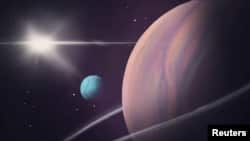For only the second time, researchers have found what appears to be a moon orbiting a planet in another solar system. Just like the first time, this one has qualities that suggest such moons may differ greatly from those in our solar system.
Data captured by NASA's Kepler space telescope before it was retired in 2018 suggested the presence of a moon 2.6 times the diameter of Earth. This possible moon was orbiting a Jupiter-sized gas planet about 5,700 light-years away from our solar system, scientists said recently.
A light-year is the distance light travels in a year, 9.5 trillion kilometers.
This moon's diameter would make it larger than any of the roughly 220 ones known to be orbiting planets in our solar system. It is also more than nine times the diameter of Earth's moon.
David Kipping of Columbia University was the lead writer of the research that appeared in the publication Nature Astronomy
Kipping said much remained unknown about the object. “It could be a rocky core with a light fluffy envelope or a thick atmosphere all the way down to some high-density core," he said.
Our solar system's moons are all rocky or icy objects.
Close to 5,000 exoplanets, or planets beyond our solar system, have been identified. But only two exomoons, or moons beyond our solar system, have been found. That is not because moons are thought to be any rarer in other solar systems, but because planets are generally larger and easier to find, the researchers said.
The first exomoon candidate, described in 2018 by the same lead researchers and still awaiting confirmation, is even larger. It is about the size of our solar system's planet Neptune. This possible exomoon is located about 8,000 light-years from Earth. It appears to be made of gases unlike any of our solar system's moons.
"Exomoons are terra incognita," Kipping said, using a Latin term meaning unknown land.
"The researchers employed the "transit method" often used to find exoplanets. They observed a change in the brightness of the sun-like star around which the moon's planet orbits when the planet and then the exomoon passed in front of it. The Kepler telescope obtained data on two such transits.
Study co-writer Alex Teachey of the Academia Sinica Institute of Astronomy & Astrophysics (ASIAA) in Taiwan, said this was another exciting exomoon finding, "suggesting again that large moons may be present in other planetary systems and that we can potentially detect them."
The researchers studied 70 cold, giant, gas exoplanets on wide orbits around their host stars, knowing that two such planets in our own solar system - Jupiter and Saturn - are orbited by numerous moons. They found evidence for the one new exomoon, whose size, they said, would earn it the description of being a "mini-Neptune."
"We will want to see follow-up observations to confirm its presence," Teachey said. "Even so, the present study goes a long way towards ruling out alternative explanations for the observed signals.” He added that some doubt “among the (astronomy) community is … important, but I think the paper lays out a convincing, thorough case."
I’m John Russell.
Will Dunham reported on this story for Reuters. John Russell adapted it for Learning English.
_______________________________________________________________
Words in This Story
solar -- adj. of or relating to a star and the planets orbiting around it
diameter – n. the distance through the center of something from one side to the other
core -- n. the central part of something
fluffy – adj. light and soft or airy
host - n. science the star around which objects revolve
alternative -- n. always used before a noun : offering or expressing a choice
convincing – adj. : causing someone to believe that something is true or certain








